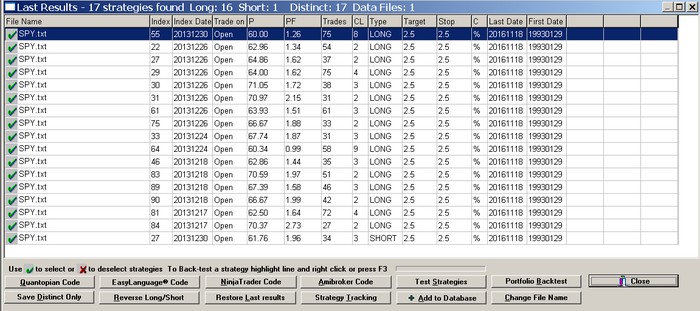Each line on the search and system tracking results corresponds to a strategy that satisfies the criteria specified on a search workspace.
Example of search results
File Name is the data file used in the search.
Index is used internally to number sub-clusters. This number is used by the program for strategy classification purposes.
Index Date is the date of the most recent trade of a strategy in the data file for Search results.
Trade on is either Open or Close and refers to the trade entry point. In the case that the Delay option was activated in search, these fields will show as Open(n) or Close(n) (ex. Open2, Close1). The value of n is the best delay for the specific strategy and it is determined based on highest profitability.
P is the percent profitability (success rate) of strategies. P = winning trades x 100/total trades.
PF is the Profit Factor (sum winners/sum losers) and shown in search results. Profitable strategies and trading systems in general require that PF > 1.
CL is the number of maximum consecutive losers of the strategy.
Type is either Long or Short.
Target shows the profit target value used in the search.
Stop shows the stop-loss value used in the search.
C indicates the type of exit applied, % stands for percentages and pts for points.
Last Date is the most recent date (last) in the data file.
First Date is the first date (oldest) in the data file.
Sorting the results
Clicking on the column labels sorts the results by File Name, Index, Index Date, percent profitability P, consecutive losers CL, number of Trades, Target or Stop and Last Date in case of p-indicator results.
Note: Although one may find evidence against the randomness of a strategy or set of strategies via the use out-of-sample testing or portfolio backtesting, including cross-validation and robustness tests, this deals only with half of the problem. The other half of the problem is that the next trade, or series of trades, can generate a loss even if the probability for that is low. This is similar to tossing a coin with a winning bias towards heads; the next toss can generate tails but in the longer-term heads will outnumber tails. From a risk management perspective, long-term statistics are not very useful when the focus is on the next few trades. The probability of win must be maximized as much as possible to minimize the risk of a large drawdown resulting from a long streak of consecutive losers in the short-term. Trading is the art and science of dealing with probabilities. A high win rate in conjunction with satisfactory portfolio backtest results increases the chances of profitable strategy or system. But as in the case of tossing a coin with a winning bias, the next trade or series of trades may generate losses. This is the nature of probabilistic trading. It is recommended that long signals are avoided if the market opens with a large up gap and the same applies to short signals if at the open there is a large down gap because the signal momentum may be exhausted at the open. Furthermore, it is important to analyze the significance of these signals in the context of recent price action.
